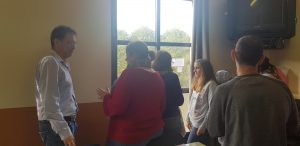Tag Archives: C1
Learn with News: a Real Time-Saver for Teachers and Students
Do you regularly read or watch the news? I don’t
Look, I know I’m supposed to act all adult-like and be like, “yeah! Every day… can’t live without knowing what’s happening in my country? Honestly? I don’t need the news- I want to be happy. Don’t you feel that nothing good ever happens in this world when you are watching the news?

But my role as an English teacher is to encourage exposure to examples of language in different contexts, from different sources and from different speakers. And this is precisely the reason why I am posting about this helpful site.
Learn with News is an English news website and you are gonna love it ’cause it’s free. In 3 levels. With exercises. Bonus points: with answers.
If you are a student
- you get to choose the level of the news. There are three levels: level 1 for beginners, level 2 for intermediate students and level 3 for advanced students.
- They provide materials for reading, vocabulary, speaking and listening
- They provide the answers.
If you are a teacher
- What is there not to love? They have prepared your class for free. Yay!
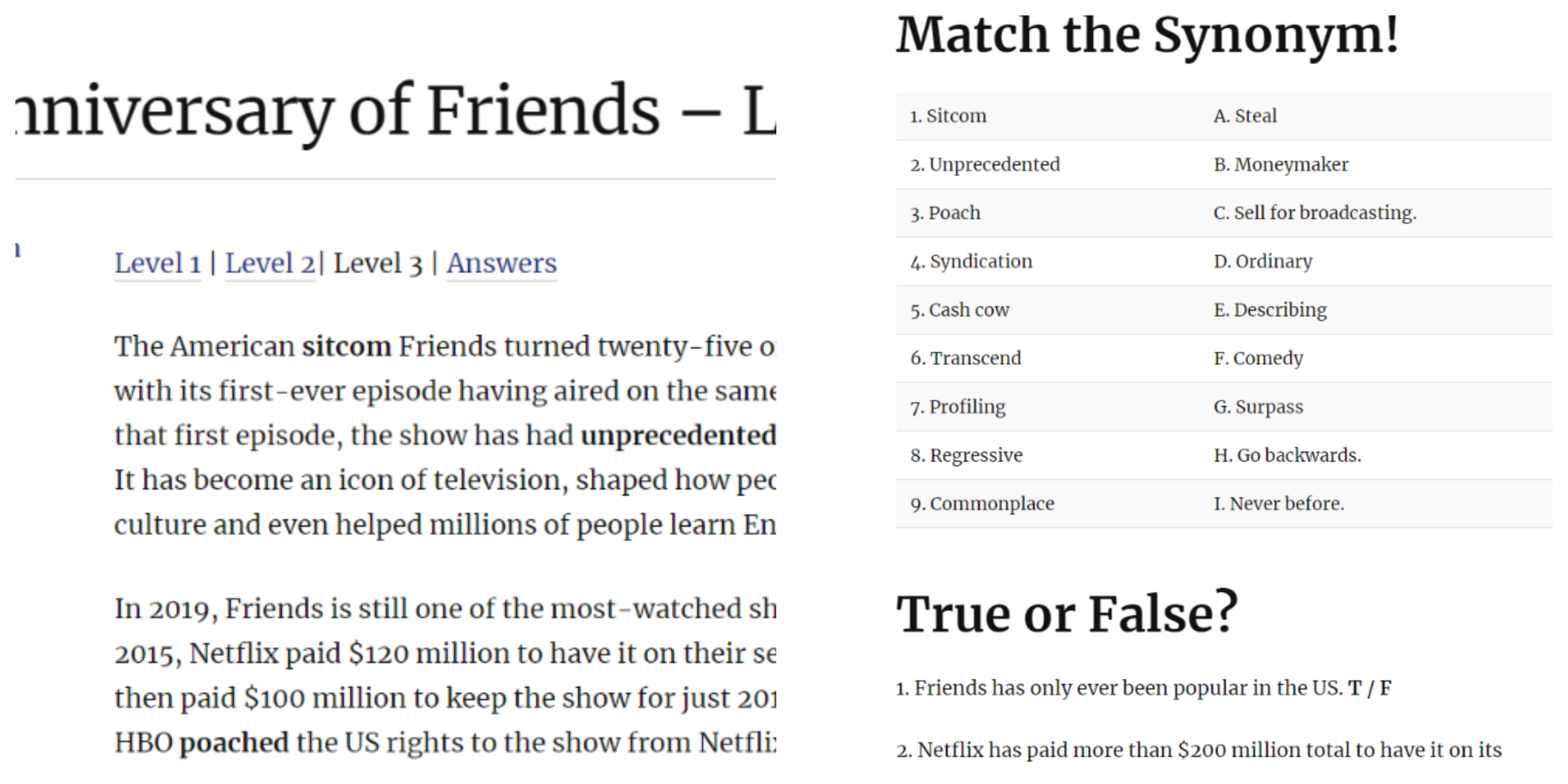
The 5 Seconds Game to Revise Vocabulary
I have realized something about myself today. Vocabulary revision games are my thing.
All my good lessons begin with revision. I make a point of beginning my classes revising what we learned the previous lesson. It takes five minutes, but I honestly believe it makes a big difference. The little game below takes exactly that, 5 minutes. Just saying.
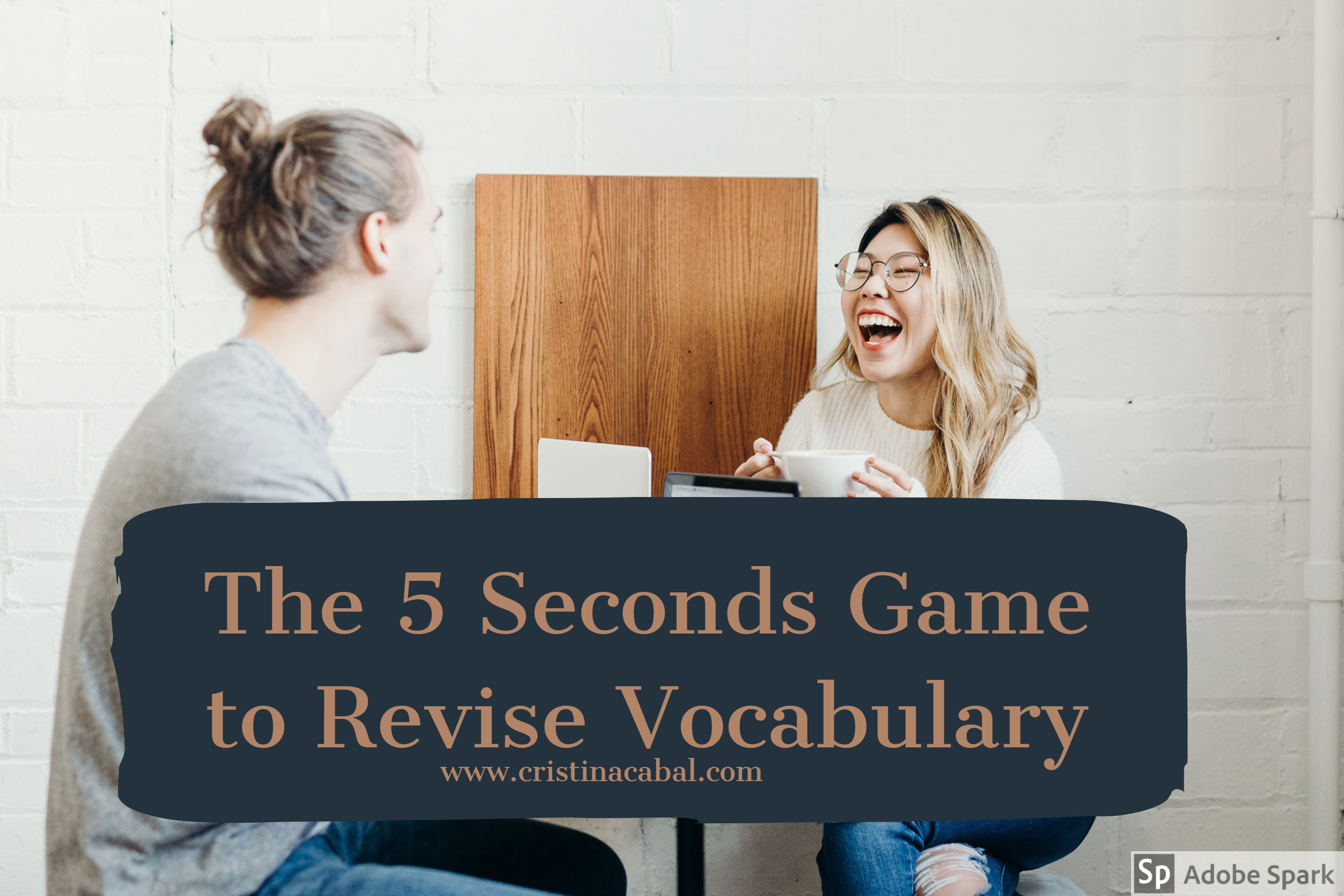
If you’ve been following this blog for some time, you probably know by now that one of my most nagging worries- shall I call it an obsession?- is teaching vocabulary about a certain topic and then hearing my students speak about the topic without a trace of the vocabulary we have been learning.
I never get angry. Believe me. I am a very nice teacher. But this,… I can hardly restrain myself.
So, again, I have designed a fun little activity to revise vocabulary, collocations…etc about any topic and I have called it “The 5 seconds game”.
Before the class:
Prepare a set of 7-10 small questions for each pair. They need to be quick questions. Have a look at my questions below. They are all about Unit 1 dealing with “Education”

In class:
- Ask students to choose a partner. After pairing up, each pair become a team and play against another team. So, we will have Team A and Team B ( 4 students)
- Tell teams you will ask each team X questions. After each question, they will have 5 seconds to think and when the bell rings, they will have to give the answer to the question at the same time. If the answer is the same and it is correct and they have answered at exactly the same time, they will score 1 point
- Say Team A starts. Ask them to sit facing each other and in clear view of Team B who will be listening to their answers very attentively and keeping score of the points they get.
- Ask the first question, mentally count 5 seconds, ring a bell or use any other device that makes noise and ask the two members of Team A to give the answer at exactly the same time. Team B will be in charge of making sure the rules are followed to the letter.
- Continue in the same way until the X questions have been answered.
- To reinforce, ask the questions again, but this time to the whole class.
- Repeat procedure for Team B with X new questions
VARIATION: In another group, I asked students to work in pairs, competing against each other and not against another pair. It also worked very well, probably better.
Thanks to Andrea and Paula for giving me permission to record them
Team A questions
- What do you call the school where you study and sleep?
- What preposition does “committed” collocate with?
- How do you pronounce “native”?
- Can you give me a synonym for “ obligatory?
- What’s the opposite of a “state school”?
- Which is correct “do your homework” or “make your homework”?
- Another way of saying “ to relax”
- “to assign” is a verb, what’s the noun?
Team B questions
- What do you call the school which trains students for employment?
- Which is correct “do an exam” or “make an exam”?
- When you pass an exam with high marks, you can say that you pass it with flying….?
- What do you call the money that you pay to attend a school?
- How do you pronounce the word “machine”?
- What preposition do you use with the verb ”keep” to mean “to go as fast as”?
- “To rehearse” is a verb, what’s the noun?
- What preposition does “ hopeless” collocate with?
Messy Words: a Vocabulary, Writing and Speaking Activity
It is October and autumn has officially hit. I am just beginning to come to terms with the fact that days are getting shorter and warm days are saying their goodbyes. Well, welcome autumn! I am all here for you!
Let’s kick it off this new season with a vocabulary revision activity that aims at reinforcing vocabulary while at the same time providing an opportunity for students to stretch their legs and interact with other students in the classroom. Gallery-walks, my favourite!
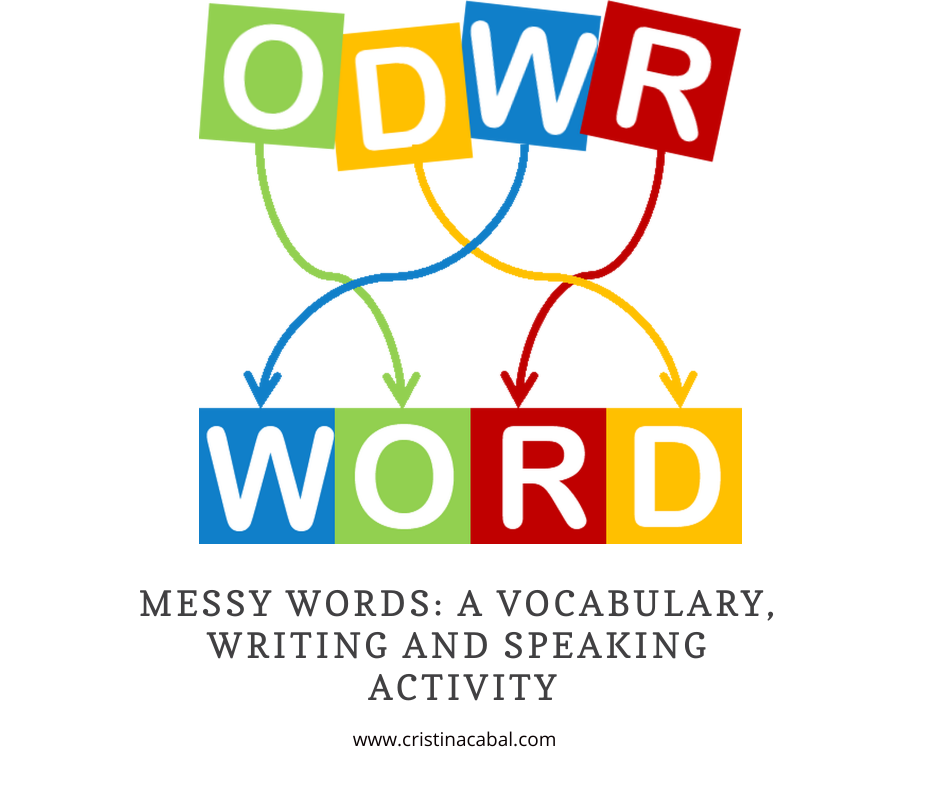
Aim:
- to reinforce the vocabulary of the lesson
- Use the vocabulary in context by
- writing an open-ended question containing the target word/expression
- answering the question by using the gallery-walk class dynamics
Procedure:
Before the class
- Choose a few words you want to revise. I suggest 8-10 words.
- Fold a regular sheet of paper horizontally and cut it in half. You will get two slips of paper. This is a good opportunity to recycle the back of spare photocopies from other courses.
- Write the letters of each word/expression you want to revise in random order. Number each of the slips of paper for easier reference.
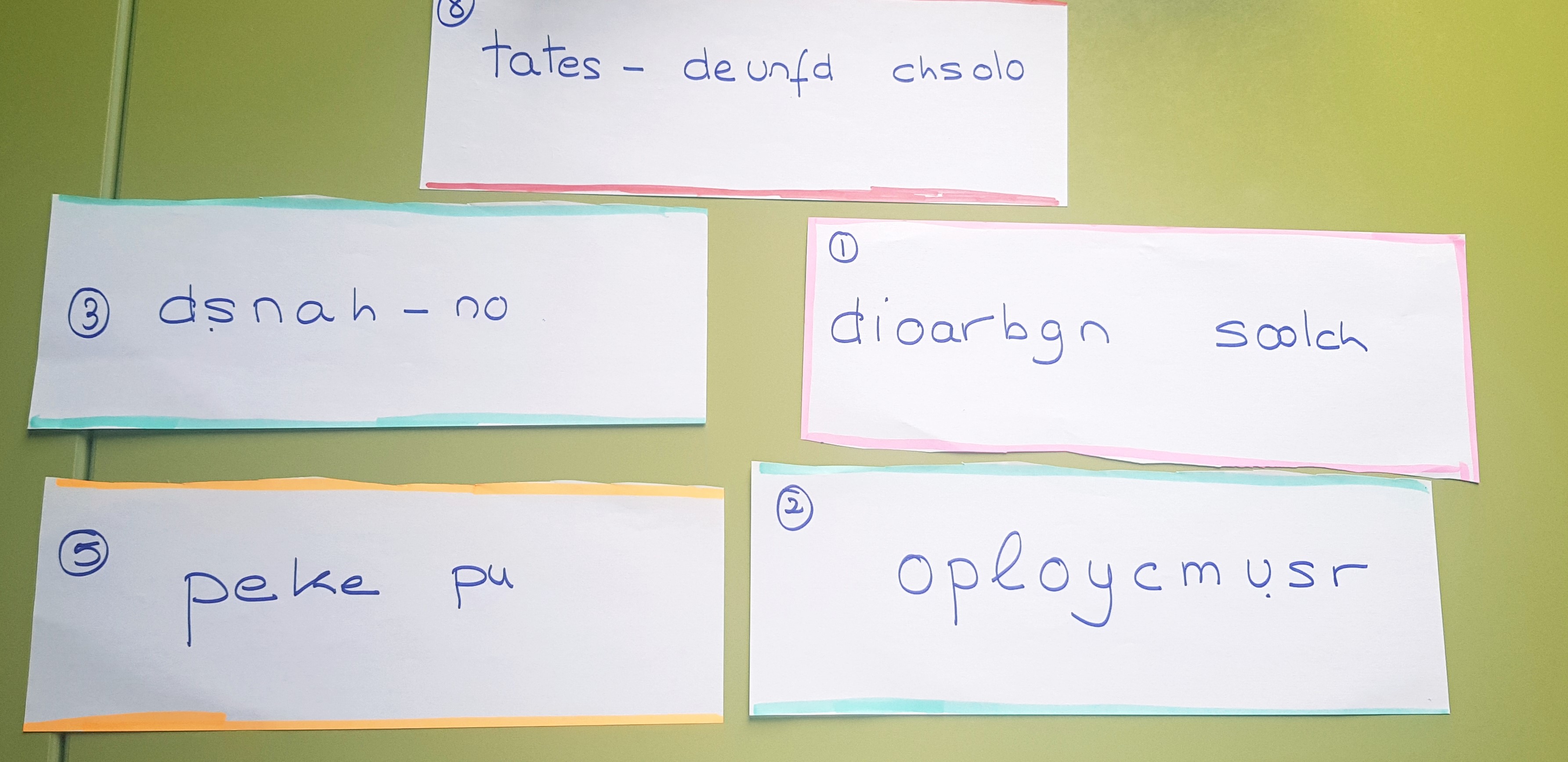
During the class:
Step 1. Slips of paper on the walls
Put up the slips of paper on the walls of the class and ask students in pairs or in threes to stand up and work out what the hidden word on each slip of paper is. Ask them to number them as displayed on the walls. The first pair to have all the words, rings the bell (needless to say, there should be one on my table) and the rest of the class has one extra minute to finish this part.
Ask students to sit down.
Step 2. Writing open-ended questions
- Students continue working in their pairs. Assign the pairs two of the words/expressions on the walls and ask them to write two open-ended questions –one per term– related to “education” (this is the topic this week) containing the word or expression.
For example, one of the words was “state-funded school” and one of the questions was “Would you send your children to a state-funded school? Why (not)?”
- Give them small cards to write their questions and, using sellotape, place them next to the term the question refers to. Ask them to write their names at the back of the card so that you know who has written the question and to give feedback.
- Quickly correct the questions on the walls, and if there is more than one per word, choose the best one, which will remain displayed together with the slip containing the word in random order. Give the discarded questions back to their owners and allow them some time to focus on their possible mistakes.
Step 3. Speaking. Gallery walks
With the words and the questions displayed on the walls, ask students in pairs to stand up and choose a station (slip+card).
Instruct them to answer the question elaborating on the answer. Allow 5 minutes/station and then ask them to move clockwise to the next station. Repeat procedure.
Until next post! 🙂
Flexible Seating Using Collocations
What could be the advantages of sitting always in the same place working with the same partner? Can you see any? I can’t. The activity below has been designed to give students plenty of opportunities to work with different partners in an engaging way. It is very flexible and lots of fun.
But first of all, a small intro. It is my first post in a long, long time so please bear with me. 😉
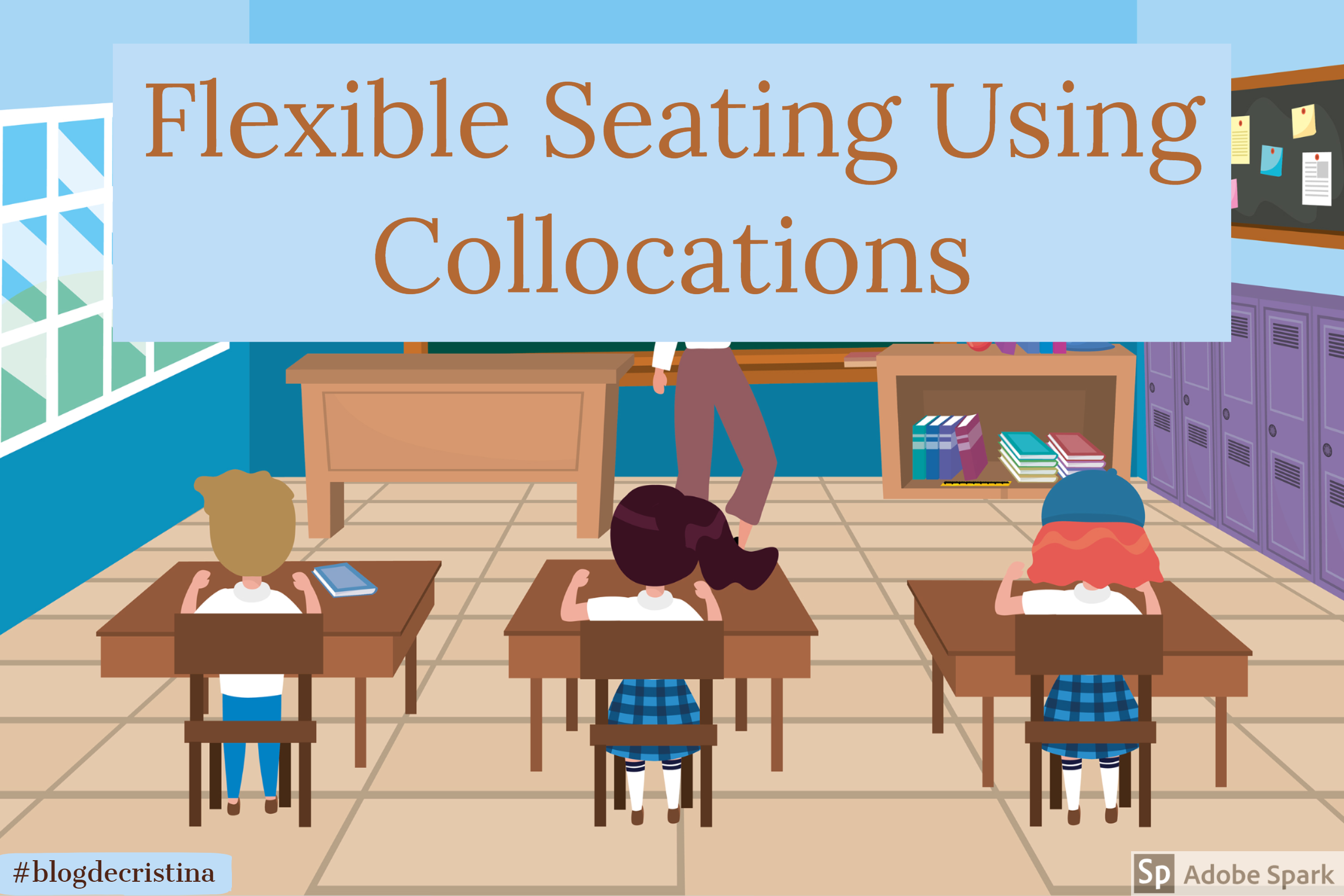
It is October!
If you are wondering, no, we haven’t started classes yet. I’ll be greeting my new students tomorrow, 7th October. I can’t wait! I already know my classes are full. 25 students and some more on a waiting list. I am a bit worried because my class is tiny. One of the smallest in the premises but hey! I am not sharing it with any other teachers. It’s just for me, so I am not complaining. However, I like to do activities where students get up from their seats and move around the class and that’s going to prove difficult in this smallish class. I guess I will just need to use the hall for some activities.
Isn’t it true that we spend most of our day at school or work sitting down? And after some time, sitting down gets boring, doesn’t it? Well, in this activity students will need to stand up, move around the class and then sit down several times. Just my kind of activity. Besides, it can be adapted flexibly and creatively in different contexts and situations. At the end of the post, you can read some other ideas I have to teach or revise vocabulary using this classroom dynamics.
Aim
- to revise very common collocations
- to ask and give information about yourself
- to provide opportunities to get to know everybody in the class
- to provide a friendly environment where students do not feel uncomfortable making mistakes and can learn from each other.
Time: 30-40 minutes
Preparation:
- The collocations. Prepare a set of common collocations. You will need one per student. I have 25 students, so I will need 25 collocations. For example: break the law or fail an exam. On a card, write break or fail; on another card write the law or an exam. The cards containing the second part of the collocation (the law, an exam) should be sellotaped to the back of the chairs of the classroom, visible to all the students. I use different colours for easy differentiation. (see picture below)
- NOTE: it is important that the collocations are unique, ie, that they can only match once. For example: if you have break //the law, you cannot have twist //your arm; as break can also collocate with arm as in break//your arm. It is useful to keep a list of the collocations you are using for agility purposes.
- The questions to discuss. Prepare a set of questions; in my case, and for this class, of the type get-to-know-each-other questions. I have prepared 25 but you can easily just use half the questions and have students share and talk about the same card.
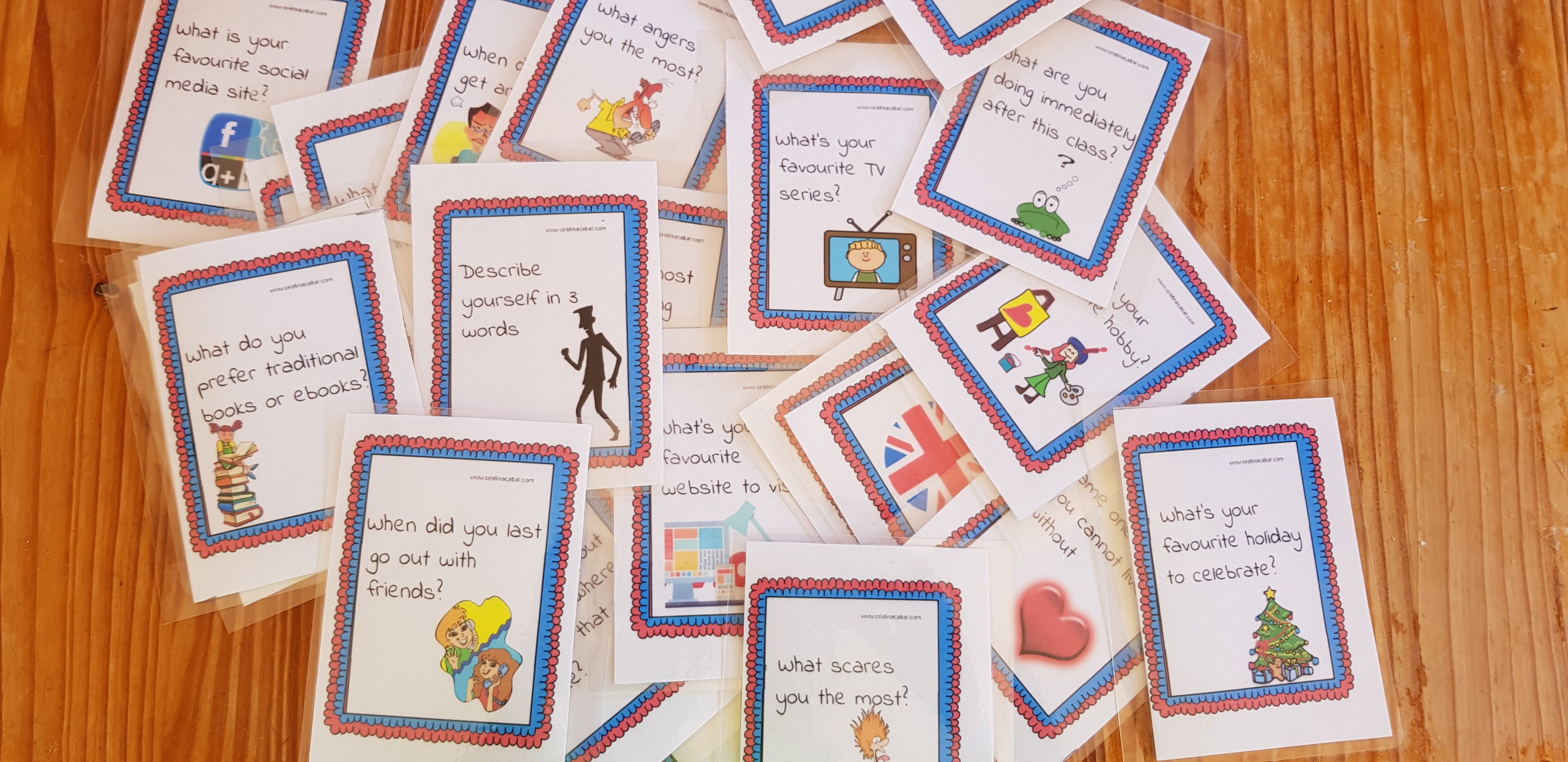
Downloadable Materials:
Procedure:
- Greet students at the door and hand them a card containing the first part of the collocation.
- Explain that they will have to find the second part by reading the cards taped on the chairs.
- Once they have found the matching card on a chair, they should sit down on that same chair.
- Quickly check that everybody has found the right collocation and if they haven’t, ask students to work out where the matching part is before you intervene. It is good to make mistakes. That’s very often how you learn.
- Ask them to say their collocation aloud so that the class can also revise it.
- Once they are in their right seats, hand them a card containing a get-to-know-you question. Encourage them to include their collocation in their conversations.
- Ask them to leave the cards containing the get-to-know-you questions on the table. They can remain there for the next students.
- Allow 6-7 minutes’ conversation and then collect the cards containing the first part of the collocation. (in the picture below, the pink ones)
- Shuffle them, hand them out to different students and repeat procedure so that students get the chance to sit in another place and talk to a different student.
- This second time, when students say their collocations aloud, ask them to pause for a second to give the class the chance to provide the second part of the collocation. This way, we reinforce without effort.
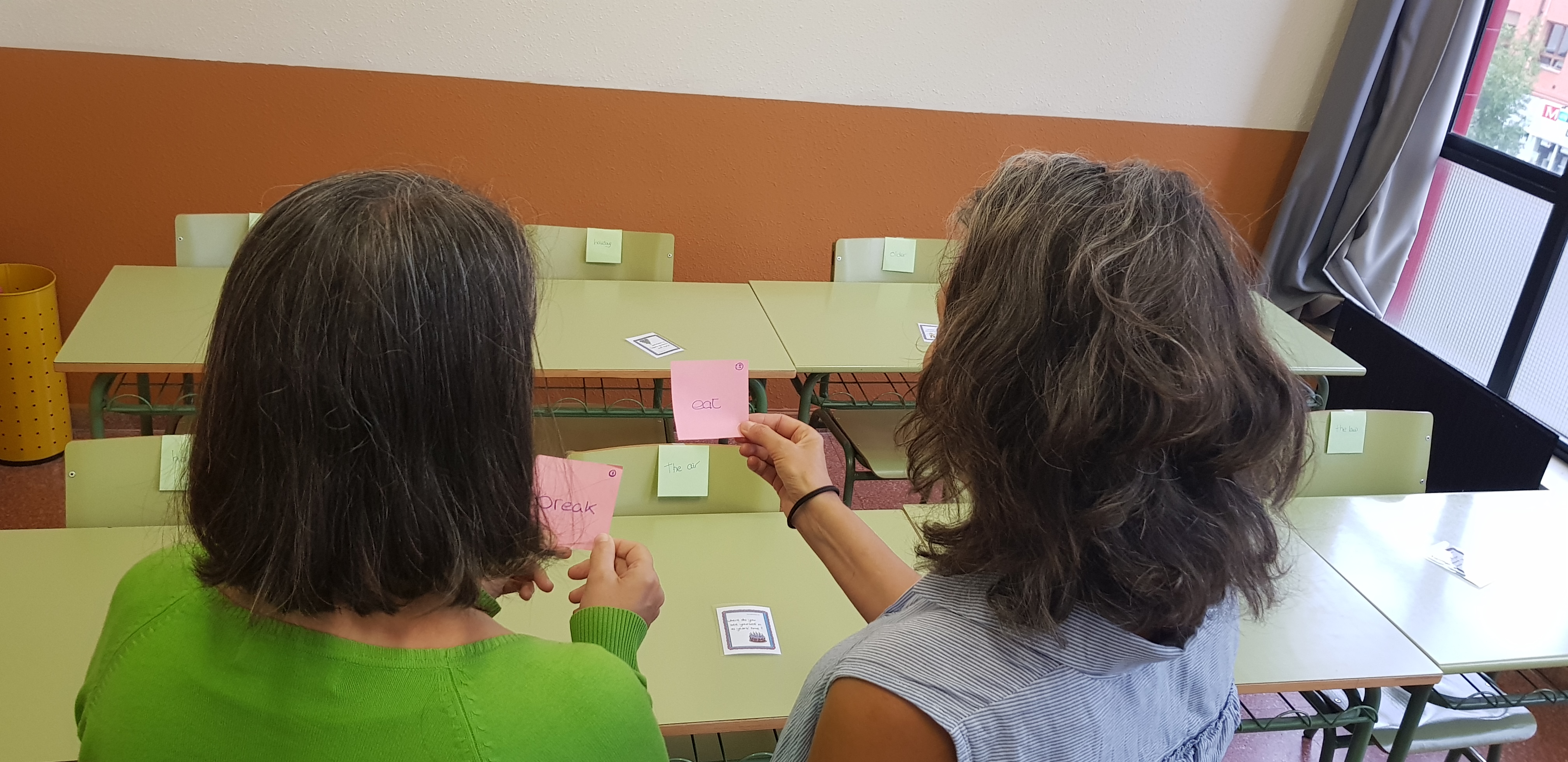
TIPS:
- I did the activity 4 times. The first time students found it harder to find the right collocation than the second time; the third and fourth time, they were incredibly quick.
- I asked students to focus on their cards and read them carefully. Sometimes, the key to finding the right collocation resides in an article or a preposition.
- The first and second time, and always before the speaking activity, I asked students to read their collocations aloud so that everybody got familiar with them. The third time, I asked them to try to remember their collocation without looking at the back of the chair. The fourth time, I asked students to read aloud just the first part and then pause, giving the class the opportunity to provide the matching collocation. Revising, reinforcing and consolidating. That’s what we are aiming for.
- At the end of the activity, I asked students to write down all the collocations they could remember and wrote them on the board to correct spelling mistakes. I gave a sweet to the student who remembered the most collocations 🙂
VARIATIONS
- Working with the vocabulary of a certain topic; on the chairs sellotape the cards containing the term and give students the cards containing the definition. For example, if I am teaching Education: on one card professor (taped on the chair) and on the other card a senior teacher at a university or college; and on the table a question such as: What was your favourite subject at school?
- Working with phrasal verbs: term//definition
- Working with compound nouns: first half// second half. For example: sitting// room
- Working with phonemic transcriptions; on one card the phonemic transcription; on the chair the card with the matching word /si:n/ seen
- Working with functional language; on one card the function in the form of a question and on the chair, a card with a possible answer. The follow-up task might be to continue the dialogue.
I don’t know. So many possibilities. The limit is your imagination.
